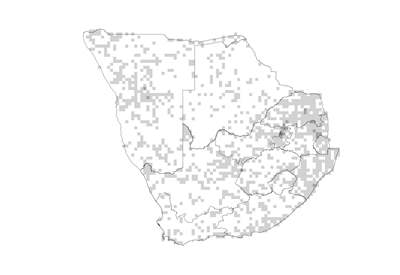 Species distribution and density. Darker squares represent higher density of members of this family. |
Introduction
Cucumber family
A family of annual and perennial climbers or creepers, usually with tendrils and a rough indumentum. Many species are cultivated and of economic importance as food plants, including pumpkin, watermelon, cucumber and melon.
Distribution
Mainly in moist to dry tropical and subtropical regions. In southern Africa this family is best represented in KwaZulu-Natal, on the Mpumalanga escarpment, and the Highveld.
Number of genera in the world
ca. 120
Number of species in the world
ca. 735
Number of genera in the Flora of southern Africa region
16
Number of species in the Flora of southern Africa region
78
Well-known southern African genera
Citrullus, Coccinia, Cucumis, Gerrardanthus, Kedrostis, Lagenaria, Momordica, Peponium, Trochomeria, Zehneria
Growth forms
Mostly annual or perennial climbing or creeping herbs or shrubs, which may be monoecious or dioecious.
Habitats
Found in woodland, grassland, savanna, desert and semi-desert areas.
Flagship species
Cucumis metuliferus (African horned cucumber; rooikomkommer [A]; mokapana [T]) is a highly ornamented and attractive member of the family which is widely cultivated as a food plant and sought after by plant collectors as a curiosity. The fruit varies in degree of bitterness and is eaten raw or cooked and the sap drained as a source of water. The leaves are sometimes cooked as a type of spinach. In the folklore of some of the traditional tribes the pounded roots mixed with other compounds are used to ward off evil spirits and ghosts. (Photo: GN).
Significance of the family
The family is important in agriculture where mostly the fruit (and sometimes the leaves) are used as a source of food. These include cucumber, gherkins, melon, pumpkin, squashes, watermelon and zucchini. Many indigenous inhabitants of the drier areas in Africa, both man and beast, use fruit of the tsamma (Citrullus lanatus) and narras (Acanthosicyos species) as a source of food and water. Many species of gourds (Lagenaria) have been used as containers and as medicines.
Diagnostic characters
Mostly herbs with trailing stems (creepers and climbers). Leaf axils usually carry lateral and sometimes branched tendrils . Stems and alternate leaves covered in rough hairs. Leaves without bracts usually with palmate venation and a watery sap. Flowers regular , unisexual and axillary. Corolla consists of 5 fused, usually white, yellow or orange petals. Anthers mostly 3, variously fused, usually bent or undulate �. Ovary inferior �. Stigma usually has 2 or 3 fleshy lobes. Fruit a large berry with a hard leathery wall, sometimes with prickles or warts; with parietal placentation. Seeds � flattened .
Did you know?
The earliest record of human use of edible cucurbits is from Mexico where stored seeds of squashes were found in ruins dated to � 5 000 B.C.